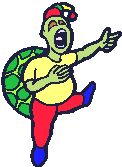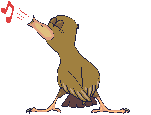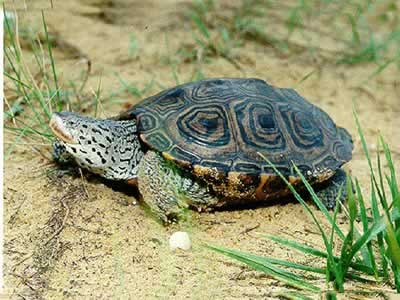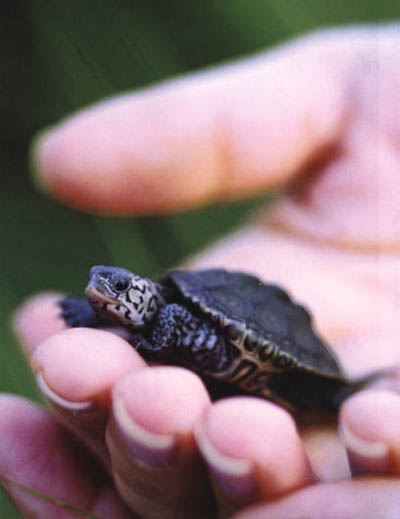|
|
Canku Ota |
|
|
(Many Paths) |
||
|
An Online Newsletter Celebrating Native America |
||
|
January 25, 2003 - Issue 79 |
||
|
|
||
|
How the Partridge Got His Whistle |
||
|
Cherokee Legend
|
||
|
|
I The Terrapin was constantly going about whistling and showing his whistle to the other animals until the Partridge became jealous, so one day when they met the Partridge asked to try the whistle. The Terrapin was afraid to risk it at first, suspecting a trick, but the Partridge said, "I'll give it back right away, and if you are afraid you can stay with me while I practice." So the Terrapin let him have the whistle and the Partridge walked around blowing on it in fine fashion. "How does it sound with me?" asked the Partridge. "Oh, you do very well," said the Terrapin, walking alongside.
"That's fine," answered the Terrapin, hurrying to keep up, "but don't run so fast." "And now, how do you like this?" called the Partridge, and with that he spread his wings, gave one long whistle, and flew to the top of a tree, leaving the poor Terrapin to look after him from the ground.
Print
and Color Your Own Terrapin Here: |
|
|
|
Diamondback Terrapin |
|
Hunted to near extinction to make terrapin soup in the late 1800's and early 1900's, the future of the diamondback once looked very bleak. Fortunately, tastes change and terrapin soup is no longer the popular dish that it once was. Also, laws were passed to protect the terrapin. These two changes have made it possible for this animal to slowly rebuild its populations. A
Salt Marsh Turtle Terrapins are reptiles, as are all turtles. Snakes, lizards and crocodiles are other reptiles. Turtles are the only reptiles that do not have teeth. Instead they have strong horny beaks. They are also the only reptiles with hard shells. The top shell is called the carapace and the bottom shell is called the plastron. A turtle's backbone is attached to its top shell. The carapace of the Maryland terrapin may be light brown, gray or black. The plastron is yellow to olive in color. The outside of the top shell is covered with thin, shiny scales called scutes. Turtle's scutes and beaks are made of a protein called keratin. Keratin is also found in hair, fur, horns, hooves and fingernails. The scutes on some Malaclemys have concentric rings which earned this group the nickname "diamondback." Because one ring is formed each year, counting them may give a rough estimate of the age of the terrapin. This is not a reliable method to use, however, since the edge of the scutes often flake off. The scaly skin of terrapins often has striking black and white color patterns. Black spots and short squiggley lines create a design that is unique for each animal. Diamondbacks also have webbed feet, which make them able swimmers. Sharp claws help them climb up muddy riverbanks. Female terrapins are much larger than the males, more so than any other North American turtle. Fully grown male terrapins are about 130 mm (5 in) measured along the plastron and weigh about 500 g (17 oz). Females average 190 mm (7.5 in) with some large individuals reaching 200 mm (8 in). Large females may weigh as much as 2 kg (4.42 lb.). Nesting
and Hibernation If the terrapin eggs do not hatch before cold weather sets in, the hatchlings may overwinter in the nest and not come out until the following spring. This is not unusual because terrapins and many other turtles hibernate each winter. When the first cold weather arrives, they bury themselves in mud banks. Their body functions slow down greatly and they do not need to come up to breathe. If there is a break in the cold weather, the terrapins may come out to take advantage of the warmth. Hibernation ends in the spring and mating takes place soon afterwards. Most turtles live for a long time, and diamondbacks are no exception. They live to be at least 40 years old, perhaps even longer. However, most do not make it out of the nest or live beyond the hatchling stage. Their enemies include muskrats, crows, raccoons and skunks which dig up the nests and eat the eggs and baby terrapins. Raccoons also attack adult terrapins. Many are killed by cars when they cross the road at the marsh edge to lay eggs. New Jersey has turtle crossing signs to alert motorists an d protect the turtles. However, people and their desire for terrapin soup, did far more damage to the terrapin population than all of these factors combined. Cheaper
by the Dozen Maryland passed a law in 1878 making it illegal to take terrapins between May and October. However, in 1920, the catch was down to 823 pounds and the terrapin was in danger of being completely wiped out. In 1929, more laws were made to protect the terrapin and still exist today. According the Maryland State Department of Natural Resources, no terrapin can be taken between April 1 and October 31. When hunting is allowed, animals cannot be taken that are less than six inches long on the plastron. Also, it is illegal to "take, destroy or tamper with terrapin eggs." A license is required to hunt terrapins, but there is no limit on the number taken. These laws do help, but there are still problems which threaten diamondback terrapins. The only terrapins that are larger than six inches are the females. If females are taken during hunting season, fewer and fewer eggs are laid. Also, many adults are injured or killed by boat propeller blades. Terrapins drown in crab pots where they are lured by the bait meant for blue crabs. Although figures are not available on the diamondback population in Maryland, it is probably safe to say that they will never be as plentiful as they were in the eighteenth century. The word "terrapin" is derived from the Algonquian Indian word "torope" and is used to refer to a variety of North American aquatic turtles of the family Emydiolae, especially the genus Malaclemys. The diamondback terrapin is the state reptile of the state of Maryland and the official mascot of the University of Maryland. |
|
|
||
| Outstanding ccna exam free exam questions download are always very demanded in relevant seasons and act online prep practice test get here. Guys also appreciate scwcd questions selection. Besides affordable ccna exam are also highly appreciated by trend setters. You can find here ged test. | ||
|
|
||
|
|
||
| Canku Ota is a free Newsletter celebrating Native America, its traditions and accomplishments . We do not provide subscriber or visitor names to anyone. Some articles presented in Canku Ota may contain copyright material. We have received appropriate permissions for republishing any articles. Material appearing here is distributed without profit or monetary gain to those who have expressed an interest. This is in accordance with Title 17 U.S.C. section 107. | ||
|
Canku Ota is a copyright © 2000, 2001, 2002, 2003 of Vicki Lockard and Paul Barry. |
||
 |
 |
|
|
The "Canku Ota - A Newsletter Celebrating Native America" web site and its design is the |
||
|
Copyright © 1999, 2000, 2001, 2002, 2003 of Paul C. Barry. |
||
|
All Rights Reserved. |
||
 n
the old days the Terrapin had a fine whistle, but the Partridge had
none.
n
the old days the Terrapin had a fine whistle, but the Partridge had
none. "Now,
how do you like it?" said the Partridge, running ahead and whistling
a little faster.
"Now,
how do you like it?" said the Partridge, running ahead and whistling
a little faster. The
Terrapin never recovered his whistle, and from that, and the loss of
his hair, which the Turkey stole from him, he grew ashamed to be seen,
and ever since he shuts himself up in his box when anyone comes near
him.
The
Terrapin never recovered his whistle, and from that, and the loss of
his hair, which the Turkey stole from him, he grew ashamed to be seen,
and ever since he shuts himself up in his box when anyone comes near
him. The
salt marsh waters are still except for the movement caused by your canoe
and paddle. As you travel down the tidal stream, you move away from
the shore to avoid the thick patches of cord grass that line the bank.
Tiny marsh periwinkles cling to the b lades of this hardy, plentiful
plant. Fiddler crabs scurry into their burrows as you approach but you
manage to catch a glimpse of a knobby legged great blue heron. A flash
of silver lets you know that killifish are about. Suddenly, a bit of
movement in t he water catches your eye. It is a diamondback terrapin,
sticking its small head out of the water as it paddles slowly across
the stream.
The
salt marsh waters are still except for the movement caused by your canoe
and paddle. As you travel down the tidal stream, you move away from
the shore to avoid the thick patches of cord grass that line the bank.
Tiny marsh periwinkles cling to the b lades of this hardy, plentiful
plant. Fiddler crabs scurry into their burrows as you approach but you
manage to catch a glimpse of a knobby legged great blue heron. A flash
of silver lets you know that killifish are about. Suddenly, a bit of
movement in t he water catches your eye. It is a diamondback terrapin,
sticking its small head out of the water as it paddles slowly across
the stream. Diamondback
terrapins are North American turtles that live in salt marshes and nearby
tidal waters. They have been given the scientific name Malaclemys terrapin.
There are seven different kinds of Malaclemys terrapin found along the
Atlantic and Gulf coasts from Massachusetts to Mexico. Their range often
includes estuaries, coastal rivers, mangrove swamps and the open sea.
Terrapin is an Algonquian Indian word for edible turtles that live in
fresh or brackish water. Water is brackish if it contains some salt,
but it is not as salty as ocean water. Diamondbacks are the only turtles
in the world that live exclusively in brackish water. In Maryland, they
live in the salt marshes of the Chesapeake and Chincoteague Bays where
they feed on soft clams and razor clams. They also eat snails, crabs,
shrimp and even the roots and shoots of marsh plants.
Diamondback
terrapins are North American turtles that live in salt marshes and nearby
tidal waters. They have been given the scientific name Malaclemys terrapin.
There are seven different kinds of Malaclemys terrapin found along the
Atlantic and Gulf coasts from Massachusetts to Mexico. Their range often
includes estuaries, coastal rivers, mangrove swamps and the open sea.
Terrapin is an Algonquian Indian word for edible turtles that live in
fresh or brackish water. Water is brackish if it contains some salt,
but it is not as salty as ocean water. Diamondbacks are the only turtles
in the world that live exclusively in brackish water. In Maryland, they
live in the salt marshes of the Chesapeake and Chincoteague Bays where
they feed on soft clams and razor clams. They also eat snails, crabs,
shrimp and even the roots and shoots of marsh plants. Terrapins
reproduce when the males are 6-10 years old and the females are between
8 and 13. In Maryland, nesting takes place in June and July. Diamondbacks
always mate in the water, usually at night. A female lays fertilized
eggs for up to four years before mating again. Nests are located above
the hide tide mark, on river banks or the sandy edges of salt marshes.
The female digs a teardrop shaped hole about six inches deep using her
hind feet. She then deposits 5-12 pinkish-white eggs in the hole and
covers them up with sand. A female may make three or four nests. The
eggs take 60-100 days to hatch. When the hatchlings emerge, they are
only 27 mm (1 in) long and look like miniature females. With most turtles,
the temperature of the nest determines the sex of the hatchlings. At
higher temperatures, more females develop. At lower temperatures, more
males develop. It is thought that this may also happen with diamondback
terrapins. Scientists are doing studies to find out if this is true.
Terrapins
reproduce when the males are 6-10 years old and the females are between
8 and 13. In Maryland, nesting takes place in June and July. Diamondbacks
always mate in the water, usually at night. A female lays fertilized
eggs for up to four years before mating again. Nests are located above
the hide tide mark, on river banks or the sandy edges of salt marshes.
The female digs a teardrop shaped hole about six inches deep using her
hind feet. She then deposits 5-12 pinkish-white eggs in the hole and
covers them up with sand. A female may make three or four nests. The
eggs take 60-100 days to hatch. When the hatchlings emerge, they are
only 27 mm (1 in) long and look like miniature females. With most turtles,
the temperature of the nest determines the sex of the hatchlings. At
higher temperatures, more females develop. At lower temperatures, more
males develop. It is thought that this may also happen with diamondback
terrapins. Scientists are doing studies to find out if this is true.